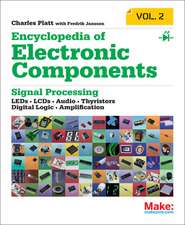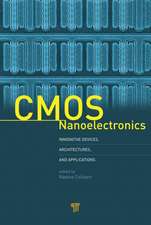Design of Efficient and Safe Neural Stimulators: A Multidisciplinary Approach: Analog Circuits and Signal Processing
Autor Marijn van Dongen, Wouter Serdijnen Limba Engleză Hardback – 3 mar 2016
| Toate formatele și edițiile | Preț | Express |
|---|---|---|
| Paperback (1) | 576.24 lei 43-57 zile | |
| Springer International Publishing – 8 apr 2018 | 576.24 lei 43-57 zile | |
| Hardback (1) | 725.26 lei 43-57 zile | |
| Springer International Publishing – 3 mar 2016 | 725.26 lei 43-57 zile |
Din seria Analog Circuits and Signal Processing
- 5%
 Preț: 902.97 lei
Preț: 902.97 lei - 9%
 Preț: 628.98 lei
Preț: 628.98 lei -
 Preț: 388.34 lei
Preț: 388.34 lei - 15%
 Preț: 636.30 lei
Preț: 636.30 lei - 15%
 Preț: 636.80 lei
Preț: 636.80 lei - 18%
 Preț: 941.82 lei
Preț: 941.82 lei - 15%
 Preț: 639.08 lei
Preț: 639.08 lei - 18%
 Preț: 918.48 lei
Preț: 918.48 lei - 15%
 Preț: 631.21 lei
Preț: 631.21 lei - 15%
 Preț: 642.03 lei
Preț: 642.03 lei - 15%
 Preț: 641.85 lei
Preț: 641.85 lei - 18%
 Preț: 887.05 lei
Preț: 887.05 lei - 18%
 Preț: 944.51 lei
Preț: 944.51 lei - 15%
 Preț: 632.55 lei
Preț: 632.55 lei - 15%
 Preț: 641.03 lei
Preț: 641.03 lei - 18%
 Preț: 836.39 lei
Preț: 836.39 lei - 15%
 Preț: 642.18 lei
Preț: 642.18 lei - 15%
 Preț: 639.90 lei
Preț: 639.90 lei - 18%
 Preț: 947.85 lei
Preț: 947.85 lei - 15%
 Preț: 642.51 lei
Preț: 642.51 lei - 15%
 Preț: 631.86 lei
Preț: 631.86 lei - 15%
 Preț: 634.49 lei
Preț: 634.49 lei - 15%
 Preț: 635.47 lei
Preț: 635.47 lei - 15%
 Preț: 640.06 lei
Preț: 640.06 lei - 15%
 Preț: 631.53 lei
Preț: 631.53 lei - 15%
 Preț: 635.65 lei
Preț: 635.65 lei - 18%
 Preț: 941.50 lei
Preț: 941.50 lei - 18%
 Preț: 1112.92 lei
Preț: 1112.92 lei - 15%
 Preț: 636.30 lei
Preț: 636.30 lei - 15%
 Preț: 633.19 lei
Preț: 633.19 lei - 15%
 Preț: 635.80 lei
Preț: 635.80 lei - 18%
 Preț: 888.01 lei
Preț: 888.01 lei - 18%
 Preț: 942.76 lei
Preț: 942.76 lei - 18%
 Preț: 1387.10 lei
Preț: 1387.10 lei - 18%
 Preț: 1115.28 lei
Preț: 1115.28 lei - 15%
 Preț: 633.68 lei
Preț: 633.68 lei - 15%
 Preț: 641.03 lei
Preț: 641.03 lei - 15%
 Preț: 638.57 lei
Preț: 638.57 lei - 15%
 Preț: 642.51 lei
Preț: 642.51 lei - 18%
 Preț: 947.85 lei
Preț: 947.85 lei - 15%
 Preț: 640.71 lei
Preț: 640.71 lei - 15%
 Preț: 640.88 lei
Preț: 640.88 lei - 15%
 Preț: 631.40 lei
Preț: 631.40 lei - 18%
 Preț: 944.19 lei
Preț: 944.19 lei - 18%
 Preț: 944.67 lei
Preț: 944.67 lei - 18%
 Preț: 942.94 lei
Preț: 942.94 lei - 15%
 Preț: 641.20 lei
Preț: 641.20 lei - 20%
 Preț: 555.52 lei
Preț: 555.52 lei - 18%
 Preț: 1003.38 lei
Preț: 1003.38 lei
Preț: 725.26 lei
Preț vechi: 884.46 lei
-18% Nou
Puncte Express: 1088
Preț estimativ în valută:
138.77€ • 145.28$ • 114.83£
138.77€ • 145.28$ • 114.83£
Carte tipărită la comandă
Livrare economică 07-21 aprilie
Preluare comenzi: 021 569.72.76
Specificații
ISBN-13: 9783319281292
ISBN-10: 3319281291
Pagini: 126
Ilustrații: XIII, 124 p. 69 illus., 48 illus. in color.
Dimensiuni: 155 x 235 x 10 mm
Greutate: 0.38 kg
Ediția:1st ed. 2016
Editura: Springer International Publishing
Colecția Springer
Seria Analog Circuits and Signal Processing
Locul publicării:Cham, Switzerland
ISBN-10: 3319281291
Pagini: 126
Ilustrații: XIII, 124 p. 69 illus., 48 illus. in color.
Dimensiuni: 155 x 235 x 10 mm
Greutate: 0.38 kg
Ediția:1st ed. 2016
Editura: Springer International Publishing
Colecția Springer
Seria Analog Circuits and Signal Processing
Locul publicării:Cham, Switzerland
Public țintă
Professional/practitionerCuprins
Introduction.- Modeling the activation of Neural cells.- Electrode-tissue interface during a stimulation cycle.- Efficacy of high frequency switched-mode neural stimulation.- System design of neural stimulators.- Design of an arbitrary waveform charge balanced stimulator.- Switched-mode High Frequency Stimulator Design.- Conclusions.
Recenzii
“This is an excellent monograph on the electronics of neural stimulators for clinical and experimental recordings including chronic spine devices for the control of pain. … The parameters of safe operation and application are discussed for neurophysiologists, engineering specialists, fellows, and students in graduate school. Junior undergraduate students will find the discussions very relevant and helpful in their work and studies.” (Joseph J. Grenier, Amazon.com, April, 2016)
Notă biografică
Marijn N. van Dongen was born in Pijnacker, The Netherlands, in 1984. He received the M.Sc. and Ph.D. degrees in electrical engineering from the Delft University of Technology, Delft, The Netherlands, in 2010 and 2015, respectively. His research interests include the design of neural stimulator output circuits as well as the modeling of the electrophysiological and electrochemical processes during electrical stimulation. Currently he is working for NXP Semiconductors, Nijmegen, The Netherlands. Dr. van Dongen served as the Financial Chair of the IEEE BioCAS2013 Conference.
Wouter A. Serdijn (M'98, SM'08, F'11) was born in Zoetermeer ('Sweet Lake City'), the Netherlands, in 1966. He received the M.Sc. (cum laude) and Ph.D. degrees from Delft University of Technology, Delft, The Netherlands, in 1989 and 1994, respectively. Currently, he full professor of bioelectronics at Delft University of Technology, where he heads the Section Bioelectronics. His research interests include low-voltage, ultra-low-power and ultra wideband integrated circuits and systems for biosignal conditioning and detection, neuroprosthetics, transcutaneous wireless communication, power management and energy harvesting as applied in, e.g., hearing instruments, cardiac pacemakers, cochlear implants, neurostimulators, portable, wearable, implantable and injectable medical devices and electroceuticals.
He is co-editor and co-author of 9 books, 8 book chapters and more than 300 scientific publications and presentations. He teaches Circuit Theory, Analog Signal Processing, Micropower Analog IC Design and Bioelectronics. He received the Electrical Engineering Best Teacher Award in 2001, 2004 and 2015. Wouter A. Serdijn is an IEEE Fellow, an IEEE Distuingished Lecturer and a Mentor of the IEEE.
Wouter A. Serdijn (M'98, SM'08, F'11) was born in Zoetermeer ('Sweet Lake City'), the Netherlands, in 1966. He received the M.Sc. (cum laude) and Ph.D. degrees from Delft University of Technology, Delft, The Netherlands, in 1989 and 1994, respectively. Currently, he full professor of bioelectronics at Delft University of Technology, where he heads the Section Bioelectronics. His research interests include low-voltage, ultra-low-power and ultra wideband integrated circuits and systems for biosignal conditioning and detection, neuroprosthetics, transcutaneous wireless communication, power management and energy harvesting as applied in, e.g., hearing instruments, cardiac pacemakers, cochlear implants, neurostimulators, portable, wearable, implantable and injectable medical devices and electroceuticals.
He is co-editor and co-author of 9 books, 8 book chapters and more than 300 scientific publications and presentations. He teaches Circuit Theory, Analog Signal Processing, Micropower Analog IC Design and Bioelectronics. He received the Electrical Engineering Best Teacher Award in 2001, 2004 and 2015. Wouter A. Serdijn is an IEEE Fellow, an IEEE Distuingished Lecturer and a Mentor of the IEEE.
Textul de pe ultima copertă
This book discusses the design of neural stimulator systems which are used for the treatment of a wide variety of brain disorders such as Parkinson’s, depression and tinnitus. Whereas many existing books treating neural stimulation focus on one particular design aspect, such as the electrical design of the stimulator, this book uses a multidisciplinary approach: by combining the fields of neuroscience, electrophysiology and electrical engineering a thorough understanding of the complete neural stimulation chain is created (from the stimulation IC down to the neural cell). This multidisciplinary approach enables readers to gain new insights into stimulator design, while context is provided by presenting innovative design examples.
- Provides a single-source, multidisciplinary reference to the field of neural stimulation, bridging an important knowledge gap among the fields of bioelectricity, neuroscience, neuroengineering and microelectronics;Uses a top-down approach to understanding the neural activation process: from electrode modeling to cell activation;
- Discusses the mechanisms leading to neural damage and considers several strategies for electrochemical balance;
- Describes novel, high frequency stimulation principles that take a fundamentally different approach, compared to existing stimulator designs.
Caracteristici
Provides a single-source, multidisciplinary reference to the field of neural stimulation, bridging an important knowledge gap among the fields of bioelectricity, neuroscience, neuroengineering and microelectronics Uses a top-down approach to understanding the neural activation process: from electrode modeling to cell activation Discusses the mechanisms leading to neural damage and considers several strategies for electrochemical balance Describes novel, high frequency stimulation principles that take a fundamentally different approach, compared to existing stimulator designs Includes supplementary material: sn.pub/extras


















